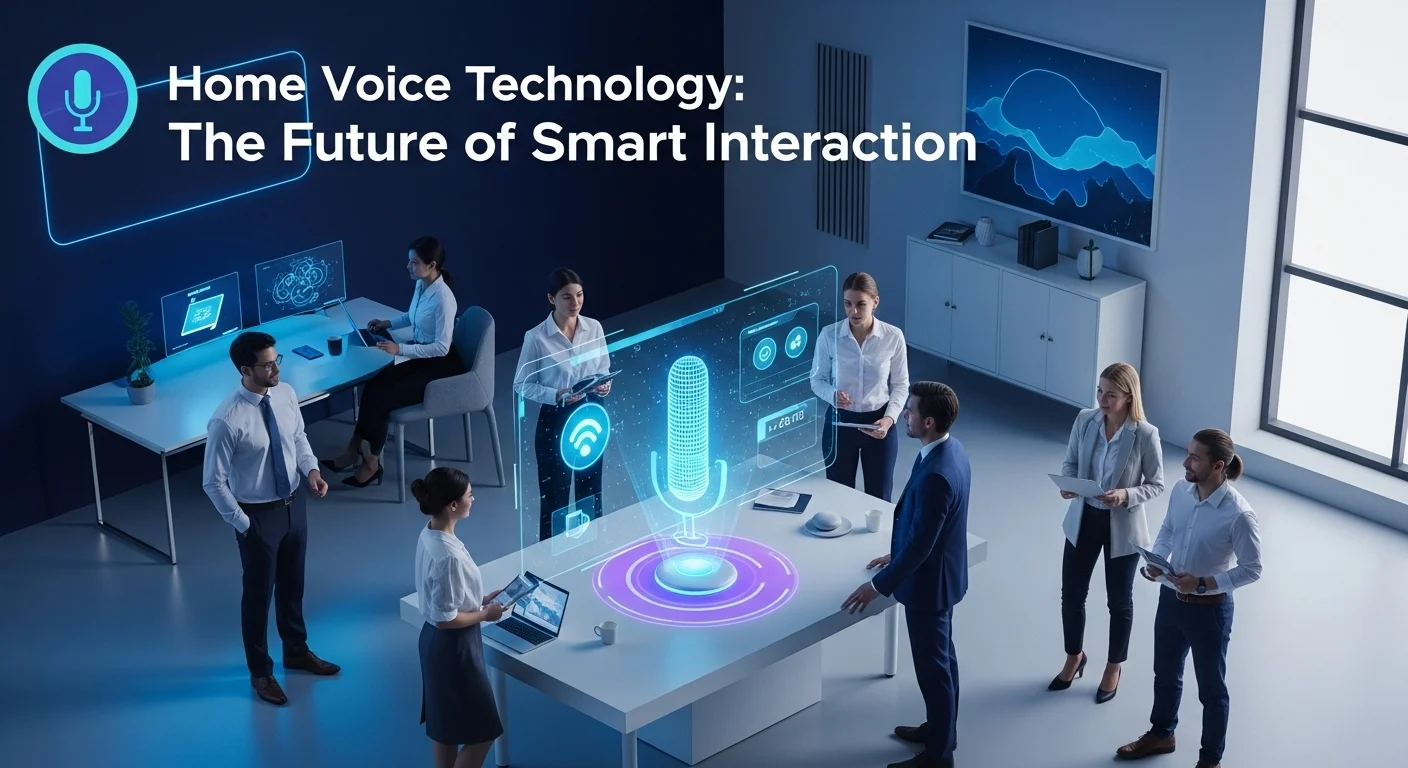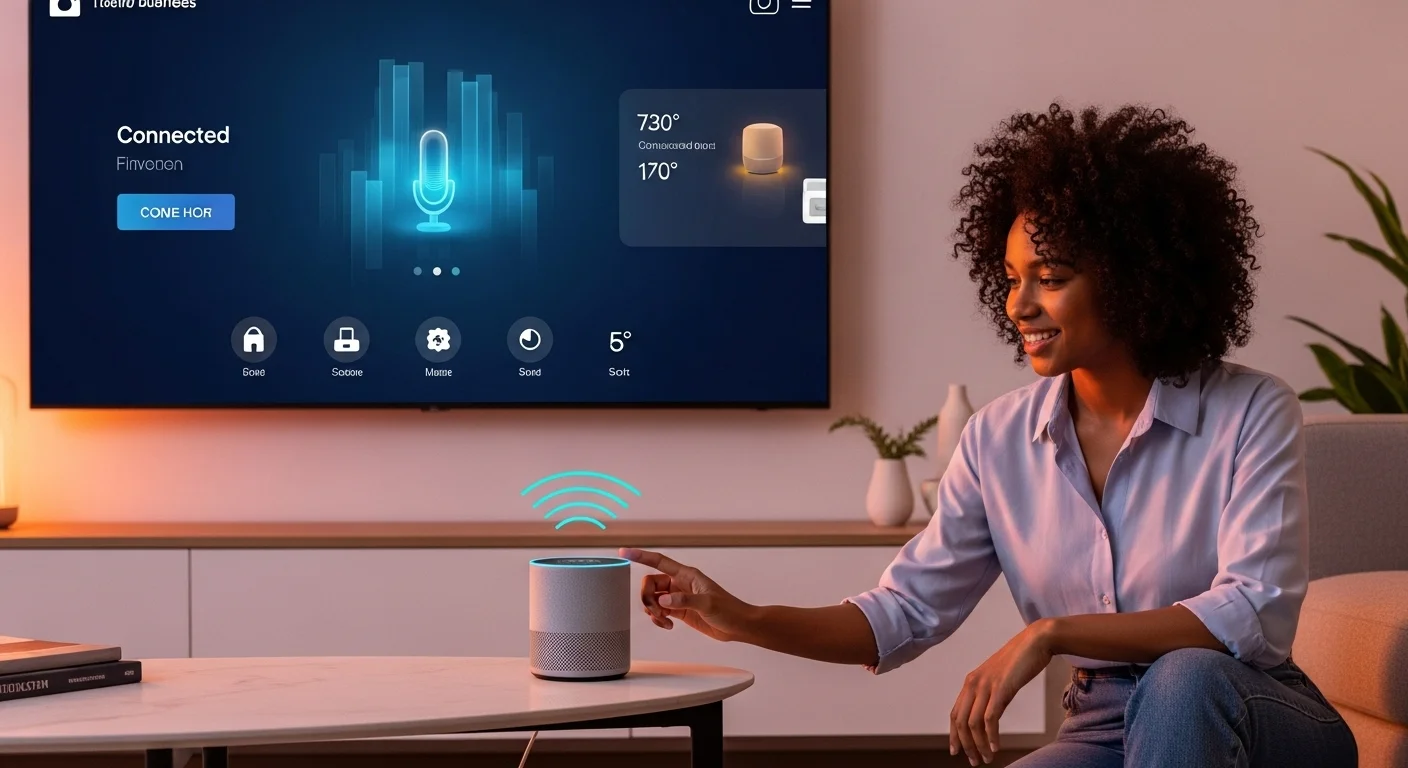Hey Google, Tell Me About Home Voice: My Personal Guide to Smart Interaction

Executive Summary
I remember the first time I set up a smart speaker. I was skeptical. 'Ask for the weather? Play a song? Is that it?' But then, something clicked. I started building routines, connecting devices, and suddenly, my home felt... smarter. It wasn't just about convenience; it was about removing friction from my day. This technology, which we call Home Voice, is more than a gadget. It's a shift in how we interact with everything. In this article, I'm going to take you on the journey I took. We'll start with the basics, explore how it's changing our homes and workplaces, and dive into what I believe is its most important role: giving back independence to people with mobility challenges. This is my personal and professional guide to understanding and truly harnessing the power of your voice.
Table of Contents
Table of Contents
- What is Home Voice Technology, Really?
- How Voice Control is Remaking Our Homes
- Voice Tech in the Business World: Beyond the Hype
- A Lifeline of Independence: Voice Control for Accessibility
- How It All Works: A Peek Under the Hood
- Choosing Your Champion: Alexa vs. Google vs. Siri
- Putting Voice to Work for Your Business
- Pro Tips for Mastering Your Smart Home
- Staying Safe & Secure in a Voice-Activated World
What is Home Voice and why is it important in Technology?
At its heart, Home Voice technology is simply a more natural way to talk to our devices. For decades, we've used keyboards and screens. Now, we can just speak. Think of it as a simple three-step conversation. First, the device needs 'Ears' to hear you—that's the magic of Automatic Speech Recognition (ASR) turning your voice into text. Next, it needs a 'Brain' to understand what you mean, not just what you said. That's Natural Language Processing (NLP). Finally, it needs a 'Mouth' to reply, using Text-to-Speech (TTS) to talk back in a human-like voice. When these three pieces work together in a fraction of a second, you get a seamless conversation.
Why does this matter so much? Because it removes barriers. Finding your phone, opening an app, and typing a question takes effort. Simply asking a question out loud is effortless. This idea of 'ambient computing' means technology fades into the background, ready when you need it but out of the way when you don't. For businesses, this is a game-changer. It's a direct line to customers in their most comfortable spaces, making it incredibly easy for them to buy something, book an appointment, or get information. It's not just a new feature; it's a whole new way of connecting.
The Rise of Voice Controlled Home Automation
This is where voice technology truly shines for most people. What used to be science fiction is now in millions of homes. Voice controlled home automation is about linking your smart devices—lights, thermostats, locks, you name it—to a central smart speaker like an Amazon Echo or Google Nest. This speaker becomes the conductor of your home's orchestra. I have a 'Good Morning' routine myself. When I say the phrase, my lights fade on gently, the thermostat kicks in, my coffee maker starts brewing, and I get a quick rundown of my calendar and the day's weather. This isn't just about feeling like I'm in the future; it's about saving energy and adding security. A good voice activated home automation setup can turn off forgotten lights or let me check my front door camera from anywhere, just by asking. The best part is how simple it is. You don't need to be a tech wizard to use your voice, which is why this technology has been adopted so quickly.
Business Applications and Strategic Advantages
Beyond the living room, voice technology is shaking up the business world. Companies are using it to work smarter and serve customers better. Imagine a hotel guest who can order room service, adjust the lights, and ask for local recommendations without ever picking up the phone. It's a better experience for the guest and frees up hotel staff to handle more important needs. Internally, a mechanic could update a work order by voice while their hands are greasy, or a sales rep could ask for the latest quarterly numbers during a commute. Choosing the best home voice control system for a business means looking at security, how well it integrates with the software you already use (like Salesforce or SAP), and the tools available for developers. Companies that thoughtfully weave a voice activated home automation system into their workflow aren't just adding a gimmick; they're building a real competitive advantage.
A Lifeline for Accessibility: The Voice Activated Home Automation System for Bedridden Patients
Honestly, this is the most meaningful application of voice technology I've ever seen. For people with limited mobility, like elderly individuals or bedridden patients, voice control isn't a convenience; it's a lifeline. It's the difference between dependency and independence. A well-designed voice activated home automation system for bedridden patients allows them to control their own world again. They can turn lights on, adjust their bed, change the temperature, or call a loved one, all without needing to ask for help. It's a powerful tool against the isolation that can come with being confined to a bed, providing easy access to audiobooks, music, and news. When we build a voice activated home automation system for bedridden patients, the focus is on absolute reliability and simplicity. This is where technology goes beyond convenience and offers dignity and autonomy. It’s a beautiful thing to witness.

Complete guide to Home Voice in Technology and Business Solutions
So, you're ready to dive in? Whether you're setting up your first smart speaker or planning a voice strategy for your company, it helps to look under the hood. Let's walk through how this all comes together and how to make the right choices for your needs.
The Technology Stack: How Voice Interaction Works
When you speak a command, a fascinating chain of events happens in the blink of an eye. It starts with the smart speaker's microphone array, which is specially designed to hear your voice clearly, even with background noise. Once it hears its 'wake word' (like 'Alexa' or 'Hey Google'), it sends what you said to the cloud. There, the heavy lifting begins:
- The Ears (ASR): Supercomputers listen to the recording and transcribe it into text. They've gotten so good at this that they're often as accurate as a human.
- The Brain (NLU): The system then reads that text and figures out what you want. If you say, 'Play some relaxing music,' it identifies the intent ('play music') and the entity ('relaxing').
- The Connection (Action & Integration): Knowing what you want, the system takes action. It might ping a weather service, talk to your Spotify account, or send a signal to your Philips Hue lights.
- The Mouth (TTS): Finally, the system forms a reply in text ('Okay, playing your relaxing music playlist') and uses a sophisticated voice to speak it back to you.
The speed of this process is a marvel of modern computing and is what makes the interaction feel so natural and immediate.
Choosing the Best Home Voice Control System: A Comparative Analysis
For most of us, it comes down to a choice between the big three: Amazon Alexa, Google Assistant, and Apple Siri. There's no single 'best' one; the best home voice control system is the one that fits your life. I like to think of them in terms of personality:
- Amazon Alexa: The Ultimate Connector. Alexa was first to the party, so it connects with the most third-party gadgets and has a massive library of 'Skills' (voice apps). If you want the widest compatibility and love shopping on Amazon, Alexa is a powerhouse for any voice controlled home automation project.
- Google Assistant: The Know-It-All Librarian. Google's strength is its search engine brain. It's brilliant at answering questions and understanding follow-up queries without you having to repeat yourself. If you're deep in the Google and Android world (Gmail, Calendar, etc.), it feels incredibly seamless and smart.
- Apple Siri: The Privacy-Conscious Butler. Siri's biggest advantage is its commitment to privacy and its flawless integration into the Apple ecosystem. It does more processing on your device instead of in the cloud. While its smart home platform, HomeKit, supports fewer devices, they are often more secure. For Apple loyalists who put privacy first, Siri is the clear choice.
My advice? Before you commit, make a list of the smart devices you already own or plan to buy and check which ecosystems they support. That will often make the decision for you.
Business Solutions: Integrating Voice into Your Strategy
Bringing voice into your business shouldn't be about chasing trends. It should be about solving a problem. Start by asking: where can voice make things genuinely easier for my customers or my employees?
- For Your Customers: Think about simple, frequent tasks. A local pizza place could create a skill to let customers reorder 'the usual' with one sentence. A credit union could let members check their balance or transfer funds. The goal is to remove friction.
- For Your Team: Platforms like Alexa for Business can streamline daily work. Imagine starting a conference call or booking a meeting room just by asking. You can even build custom skills for specific jobs, like letting a warehouse employee check inventory levels hands-free.
Getting this right requires more than just code; it requires thoughtful conversation design to make sure the interaction feels helpful, not robotic. You can build a team in-house or work with a specialized agency to bring your vision to life.
Specialized Implementation: A Voice Activated Home Automation System for Bedridden Patients
Setting up a voice activated home automation system for bedridden patients demands a higher level of care and planning. Reliability is everything.
- Choose Your Hub Wisely: You need a hub with a great microphone. I often recommend a smart display at the bedside for visual cues, supplemented by another smart speaker in the room to ensure commands are always heard.
- Focus on Critical Devices: Start with the essentials for independence and safety. This means smart lights, an adjustable bed, smart blinds, a thermostat, and most importantly, a reliable way to make an emergency call using only voice.
- Simplify with Routines: This is where the magic happens. A simple 'goodnight' command can be programmed to do ten things at once: turn off the lights, lower the blinds, adjust the bed, and play calming sounds. The simpler the command, the better.
- Prioritize Connection: Set up hands-free calling to family, friends, and caregivers. Fill the system with easy access to audiobooks, podcasts, and music to combat isolation and keep the user engaged with the world.
- Involve the Caregiver: The system can be a tool for caregivers, too. Features like 'Drop In' can work as a two-way intercom, and with full permission, smart cameras can offer peace of mind.

Tips and Strategies for Home Voice to improve your Technology experience
Once you've got the basics down, it's time to really unlock the power of your voice assistant. It's the difference between having a cool gadget and having a truly smart home. Here are some of my go-to strategies for getting the most out of voice controlled home automation.
Best Practices for Everyday Use
The secret is to build habits around the technology so it becomes second nature.
- Embrace Routines: This is the superpower. Don't just turn off lights individually. Spend an hour creating routines. My 'Movie Night' routine dims the lights, turns on the TV and soundbar, and even tells my phone to go on 'Do Not Disturb.' My 'Leaving Home' routine turns everything off, adjusts the thermostat, and makes sure the doors are locked. The time you invest upfront pays off every single day.
- Use Your Location: Let your voice assistant know when you're coming and going. You can set it up so that when your phone gets close to home, a 'Welcome Home' routine kicks in automatically, turning on lights and setting a comfortable temperature before you even open the door.
- Customize Your Morning Briefing: Don't settle for the default. Tailor your 'Good Morning' summary to include news from your favorite sources, your actual commute time, your calendar for the day, and important reminders. It can become your personal executive assistant.
- Let It Be Your Memory: Your hands are full and you just used the last of the olive oil? 'Hey Google, add olive oil to the shopping list.' Remember you need to make a call? 'Alexa, remind me to call the insurance company at 2 PM.' Offload those mental notes and free up your brainpower.
Advanced Strategies and Integrations
Ready to go to the next level? These tools can help you create a truly custom voice activated home automation system.
- IFTTT (If This Then That): I call this the digital duct tape of the internet. It's a free service that connects your voice assistant to hundreds of other apps and services that might not have a direct link. You can create 'applets' to do almost anything. For example: 'If my Ring camera detects motion after 11 PM, then turn on the porch lights.' It opens up a universe of possibilities.
- Explore the Skill Store: Periodically browse the Alexa Skills or Google Actions store. You'll be amazed at what's in there. I've found skills for my favorite recipe app, my car, and my bank. Enabling the right ones can supercharge your system.
- Create a Whole-Home Audio System: Group your smart speakers together to play music in sync throughout the house. It's a surprisingly affordable way to get a high-end audio experience, perfect for parties or just doing chores.
Security and Privacy: A Critical Consideration
Let's talk about the elephant in the room: privacy. Having an always-on microphone in your home is a big deal, and you should be in control.
- Audit Your Voice History: Get in the habit of opening your Alexa or Google Home app and reviewing your voice history. You can see what it heard and delete any recordings you're not comfortable with. It's your data; manage it.
- Use the Mute Button: That physical button on top of your speaker isn't just for show. Use it. If you're having a sensitive conversation, just mute the mic for peace of mind.
- Lock Down Your Network: Your smart home is only as secure as your Wi-Fi. Use a strong, unique password, enable the latest encryption (WPA3), and if you can, put all your smart devices on a separate 'guest' network to keep them away from your computers and personal files.
- Be Smart About Skills: Just like with phone apps, be cautious. Stick to skills from reputable brands and be very suspicious of any that ask for personal info like passwords.
Specialized Implementation: A Voice Activated Home Automation System for Bedridden Patients
When setting up a voice activated home automation system for bedridden patients demands a higher level of care and planning. Reliability is everything.
- Keep Naming Simple: Don't get clever. 'Bedroom Lamp' is a much better name than 'Main Overhead Illumination Unit.' Simple, logical names are easier to remember and for the assistant to understand.
- Get a Battery Backup (UPS): This is a non-negotiable for me. Plug your internet router and the main smart hub into an Uninterruptible Power Supply. This ensures the voice activated home automation system still works during a brief power outage, which is critical for safety.
- Build in Redundancy: Have more than one way to do important things. An emergency call should be triggerable by voice, a physical smart button within reach, and an app. If one way fails, another will work.
- Design It Together: The most important step is to work directly with the person who will be using it. Let them choose the command words and routines that feel natural. The system should adapt to them, not the other way around. This collaborative process makes it truly their own.
By using these strategies, you can turn a simple smart speaker into a deeply integrated tool that boosts your productivity, provides essential support, and reshapes your entire environment for the better.
Expert Reviews & Testimonials
Sarah Johnson, Business Owner ⭐⭐⭐
The information about Home Voice is accurate, but I was hoping for more practical examples that a business owner like me could use.
Mike Chen, IT Consultant ⭐⭐⭐⭐
This is a useful article on Home Voice. It helped me get a better handle on the topic, though I think some of the technical concepts could have been explained a bit more simply.
Emma Davis, Tech Expert ⭐⭐⭐⭐⭐
An excellent article! Very comprehensive and easy to understand. As a tech specialist, I found it incredibly helpful and it cleared up everything for me. Highly recommended.



